The Brazos Performance Preview: AMD E-350 Benchmarked
by Anand Lal Shimpi on November 16, 2010 12:01 AM ESTMemory and Cache Latencies
The Brazos platform was configured with 4GB of DDR3-1066 memory. The IDF system had memory running at DDR3-1333, however AMD had to decrease clocks presumably to meet validation requirements for final silicon. I measured an 86.9ns trip to main memory, a 3 cycle L1 and a ~22 cycle L2 cache. That's a lower latency memory interface than Atom or Core 2 based processors, but a higher latency L2.
CPU Performance: Better than Atom, 90% of K8 but Slower than Pentium DC
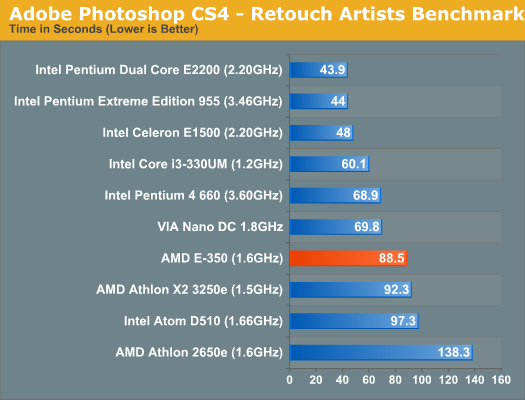
AMD's performance target for Bobcat was 90% of the performance of K8 at the same clock speed and our Photoshop CS4 benchmark shows that AMD can definitely say that it has met that goal. At 1.6GHz the E-350 manages to outperform a pair of K8s running at 1.5GHz in the Athlon X2 3250e. Unfortunately for AMD, Intel's Pentium dual-core running at 2.2GHz is much quicker. Most notebooks in the $400+ range have at least a 2.2GHz Pentium. Even the Atom D510 isn't far behind.
AMD tells me that in general purpose integer tasks, the E-350 should do well and it may even exceed AMD's 90% design target. However in higher IPC workloads, for example many floating point workloads, the E-350 is constrained by its dual issue front end. In these situations, the out of order engine is starved for instructions and much of Bobcat's advantage goes away.

Our x264 HD test has the E-350 performing within 86 - 92% of the Athlon X2 3250e, once again meeting AMD's design targets. Unfortunately, this isn't much faster than an Atom - mostly thanks to Atom's Hyper Threading support. Although not an out of order architecture, Atom gets a healthy efficiency boost by being able to execute instructions from two threads per core. Once again, compared to a 2.2GHz Pentium, the E-350 isn't close. Even VIA's dual core Nano is faster. When it comes to power consumption however, the E-350 can't be touched. I measured max system power consumption at 25.2W while running the x264 encode test. With the exception of the Atom D510, the rest of the desktop platforms here consume much more than that at idle (much less under load).
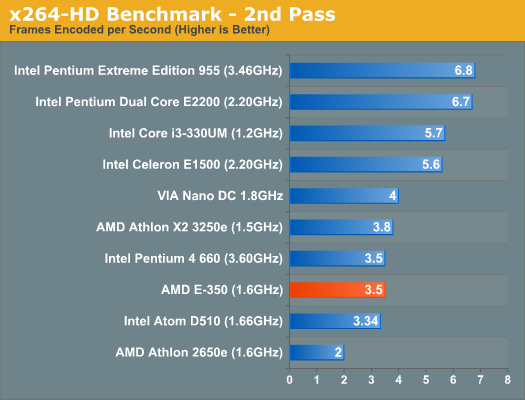
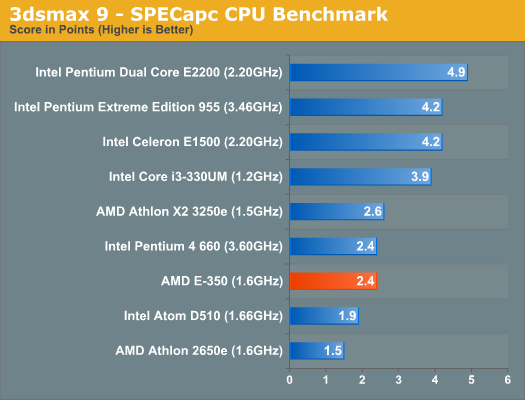
Despite being a offline 3D rendering benchmark, our 3dsmax 9 test does fall in line with expectations. The E-350 delivers 92% of the performance of the Athlon X2 3250e and outperforms the Atom D510 by 26%. Unfortunately for AMD, the Pentium dual-core holds onto a significant performance advantage here. Clock for clock, Bobcat won't be able to do much against anything Core 2 based. The real advantage here will be GPU performance.
Single Threaded Performance
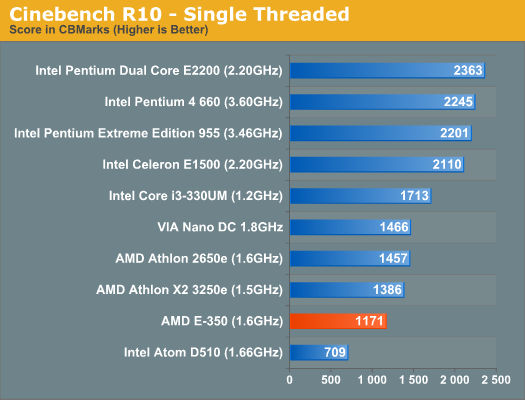
In most of our benchmarks the performance advantage over Atom isn't huge, yet using Brazos is much better than using an Atom based machine. It all boils down to one thing: single threaded performance. Atom can make up for its deficiencies by executing a lot of threads in parallel, but when you're bound by the performance of a single thread the E-350 shines. The E-350 is 65% faster than the Atom D510 in the single threaded Cinebench R10 test. It's this performance advantage that makes the E-350 feel so much quicker than Atom.
The Core i3-330UM manages a 46% performance advantage over the E-350. Even in the ultraportable Arrandale ULV space at lower clocks, AMD still leaves a lot of CPU performance on the table. The advantage here will be cost. A single E-350 is less than 40% of the die area of a Core i3-330UM. You may not get the same CPU performance, but performance per mm^2 is much higher.

In the multithreaded Cinebench test Atom is able to catch up quite a bit, but the E-350 still holds an 11% advantage.
File Compression/Archive Recovery Performance
Our final two CPU tests are both multithreaded and they show the E-350 equaling and falling behind the performance of the 1.5GHz Athlon X2. As we explained earlier, the gap between the E-350 and Atom shrinks as you add more threads to the workload.
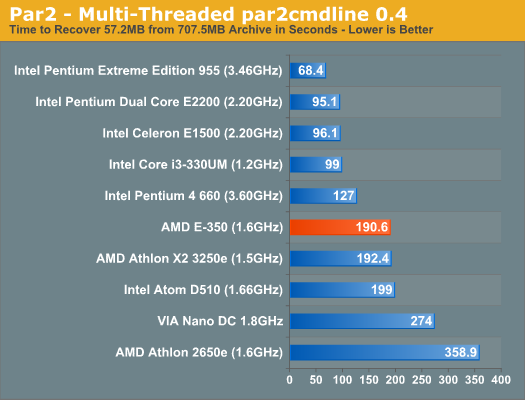
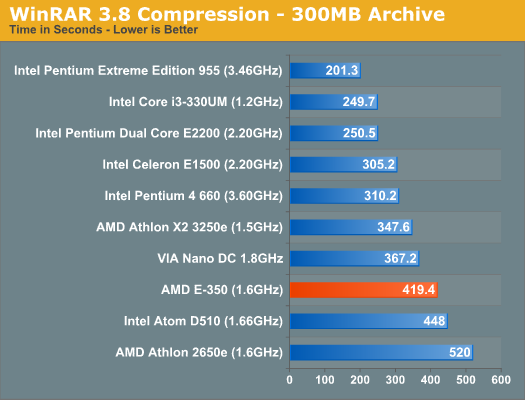










207 Comments
View All Comments
silverblue - Wednesday, November 17, 2010 - link
I admit it's rather one-sided, however there's an important point to be made - most graphics sales are integrated/low-end discrete. This is why Intel has the lion's share of the market. nVidia's fallen out of favour with Intel (and not because it did something wrong, either) and are soon to get a competitor in the ULV space which may just make purchasing ION a less clear cut decision.nVidia won't sit still, and I doubt Intel will in terms of on-die graphics. There's nothing to suggest that nVidia couldn't come up with an Optimus solution for the Brazos platform (as ironic as that may sound, though do remember it's hardly a graphics monster) in order to have as many fingers in as many pies at once. nVidia have produced very good chipsets in the past for both AMD and Intel and this alone should factor in system builders' purchasing decisions, let alone OEMs.
nVidia aren't going to die, far from it. The better they're doing, the more Intel and especially AMD have to lower prices to keep competitive.
nitrousoxide - Wednesday, November 17, 2010 - link
nVidia working on Optimus in co-op with AMD? That sounds like AMD saying to Intel: hey, use my GPUs on Sandybridge!silverblue - Wednesday, November 17, 2010 - link
By that I meant an nVidia chipset that employs a GPU switching mechanism should the x16 slot be populated.Rayb - Wednesday, November 17, 2010 - link
Just to make it clear, I understand the point you're making and the purpose of competition when a product is superior to a previous release. That's not the issue I'm debating, since the ION chipset is almost two years old and has managed to survive the ULV niche this long almost uncontested until now. I don't have any objections to Brazoz or Ontario if are proven even marginally better than other available alternatives.I don't restrict myself to one specific brand when making a purchase based on my requirements at that point. What I object is being marginalized to only one choice as alluded in (long rant by outsideloop) the third post above my reply. Which by the way since it's offset left and not intended for you, this one is.
According to his wisdom, there is no room for anybody else but his favorite company in that fantasy world. Obviously having having fruit-loops for breakfast, lunch and dinner is detrimental to your health.
nitrousoxide - Wednesday, November 17, 2010 - link
Hey about the 3rd question, 50 cents for a short post, 70 cents for a medium length post and 1 buck for a long post, that's how much those people are paid in my country :)plonk420 - Wednesday, November 17, 2010 - link
when it comes to raw CPU power, Brazos seems BARELY faster than Atom... and i feared Atom wouldn't be able to decrypt BD+ realtime with AnyDVD HD. i'm tempted to go Nano for that reason (but i sooooo want Brazos's TDP (even 25-50% more) for the Nano's computing power...nitrousoxide - Wednesday, November 17, 2010 - link
That's true in heavy multi-threaded work loads. Daily use featuring low-single-threaded work load is significantly faster than Atom. And it can at least play 1080p HD Video smoothly while an Atom struggles for 720p video playback. It is definitely faster than Atom, but how far it can go depends on its final price margin. If it is forced to encounter Sandybridge CULVs, it will definitely be wiped out.richough3 - Wednesday, November 17, 2010 - link
I currently have the Inspiron 1012 (Atom 450/GMA 3150) and the Inspiron 11z (SU4100 - 1.3 GHz/GMA4500MHD) and both have come close to what I've been looking for, but not quite.The 1012, Atom laptop, had awesome battery life, but it sucked at flash playback, running my TV tuner, and running multiple apps.
I got an Alienware M11x prior to the 11z. The graphics were awesome for an 11.6" subnotebook and battery life was good when on the integrated video, but the weight and hinge issue was why I returned it and got the 11z.
The 11z is good on battery life and did all the things the Atom laptop couldn't but it sucked for anything but basic running around in 3D games like Warcraft.
I had also considered the Inspiron M101z with the AMD K325, 1.3 GHz dual core proc, but it ran hotter and had less of a battery life than the 11z.
The E-350 APU appears to be able to address the desire for an acceptable, casual 3D experience and still provide decent performance for the other applications, along with good battery life and to provide all that in a lightweight subnotebook. Sure, I could get better performance with a heavier laptop, but I want lightness and a small footprint and I have a desktop for any heavy gaming or CPU intensive applications I want to run. I don't need a power hungry beast to play Plant vs Zombies, Diablo II, or to farm for mats in WoW, I just want it decent enough so it's not a total slide show.
iwodo - Wednesday, November 17, 2010 - link
There should be a price / performance / watt graph.Personally i am not too convinced this will succeed. Or this will solely complete where Atom is currently at, cheap and as apple correctly stated, useless Netbook area.
It is no where near even the low range Pentium E, or even Celeron.
The only area where Brazos or its derivative shines, is the cheapest computer possible.
However spending $40 - $50 you would get nearly double the performance.
Aloonatic - Wednesday, November 17, 2010 - link
I don't understand.DO you really think that Intel's product will be cheaper and improvements released more quickly without AMD as competition?
Mind boggled.